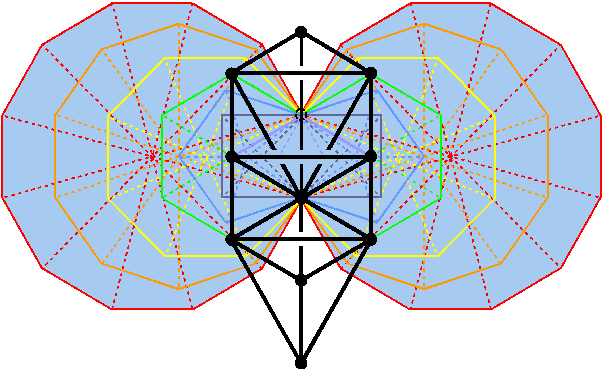
| << Previous 1... 29 30 [31] 32 33 ...40 Next >> |
#31 Correspondence between the combined Trees of Life and the table of 64 hexagrams

The outer Tree of Life consists of 16 triangles with 10 corners and 22 sides, i.e.,
48 geometrical elements, where 48 is the number value of
Kokab, the Mundane Chakra of Hod. The inner Tree of Life comprises 14 regular polygons joined at one side
(their "root edge"). They have 80 corners and 175 sides of 94 triangular sectors, i.e., 349
geometrical elements. The plane containing them passes through the outer Pillars of Mercy and Judgement but not
through the Pillar of Equilibrium, which is, anyway, bent in the 3-dimensional Tree of Life. Chokmah, Chesed &
Netzach coincide with corners of polygons, as do Binah, Geburah & Hod. The two paths making up the Pillar of
Mercy coincide with internal sides of sectors of the hexagon, and similarly for the the two paths making up the
Pillar of Judgement. Hence, three corners and two sides of each hexagon are shared with the outer Tree of Life.
These two sets of five geometrical elements are the only elements that the outer & inner Trees of Life share.
Outside the root edge, which has two endpoints and one side that are unshared with the outer Tree because the
central Pillar of Equilibrium does not lie in the plane of the 14 polygons, are (349−3=346) geometrical elements in
the inner Tree of Life. Of these, (346–5−5= 336) geometrical elements are unshared with the outer Tree
(168 elements per set of seven polygons comprising 36 corners, 85 sides
& 47 triangles). The number of geometrical elements in both the outer and inner Trees of Life outside the root
edge = 48 + 336 = 384. They comprise (10+36+36=82) corners,
(22+85+85=192) sides & (16+47+47=110) triangles, i.e., 192 corners & triangles and 192 sides (for details
of how these numbers were derived, see below). Amazingly, not only is the geometry of the outer & inner Trees
of Life outside the root edge quantified by the holistic parameter 384 (found, for example, in the I Ching table of
64 hexagrams composed of 384 lines & broken lines) but its composition
naturally divides according to types of geometrical element into two sets of 192, just
as the 64 hexagrams consist of 192 lines and 192 broken lines! The two holistic systems are
compared below:
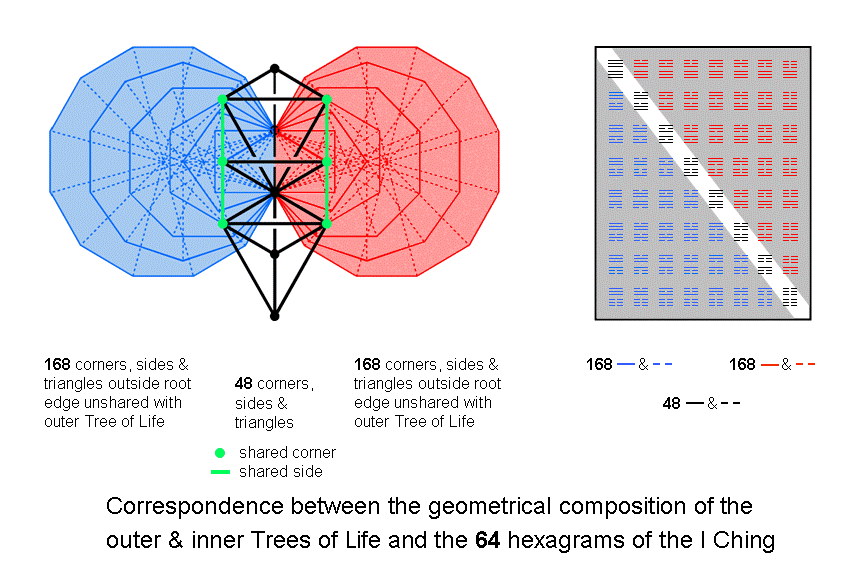
The green Sephirothic points and Paths in the outer Tree of Life are those shared with the inner Tree as, respectively, corners and sides of sectors of the two hexagons. The 48 geometrical elements making up the outer form of the Tree of Life correspond to the 48 black lines & broken lines in the eight diagonal hexagrams. The 168 geometrical elements outside the root edge making up the set of seven red polygons that are unshared with the outer Tree correspond to the 168 red lines & broken lines in the 28 upper, off-diagonal hexagrams. The 168 unshared geometrical elements outside the root edge making up the seven blue polygons correspond to the 168 blue lines & broken lines in the 28 lower, off-diagonal hexagrams. The 64 hexagrams are a representation of the outer and inner forms of the Tree of Life. They are equivalent to each other, an unbroken line corresponding to a point or triangle and a broken line corresponding to a straight line that is a side of a triangle. However, this cannot be the whole truth. The simple correspondence suggested by there being 192 points & triangles and 192 lines breaks down for the outer form of the Tree of Life because it comprises 26 points & triangles and 22 lines, whereas the eight diagonal hexagrams consist of 24 lines and 24 broken lines. It also breaks down for its inner form because the seven enfolded polygons comprise 83 corners & triangles and 85 sides outside the root edge that are unshared (see table below), whereas the 28 off-diagonal hexagrams in the upper or lower half of the table contain 84 lines & 84 broken lines. The correspondence only holds for the outer and inner Trees considered together, not for each one. If we characterize a line as "Yang" and a broken line as "Yin," correspondence can be restored for each one provided that one side of the sectors of the seven polygons be regarded as Yang instead of Yin, creating 84 Yin elements and 84 Yang elements, and that either two points, two triangles or a point and a triangle in the outer Tree be regarded as Yin rather than Yang. Is there such a side that is unique? The sides of the hexagons that are the projections of the lines connecting Daath to Chokmah and Binah are the only sides that are projections of potential Paths, namely, those connecting Yesod to, respectively, Netzach and Hod of the next higher, overlapping Tree. Their uniqueness, therefore, provides some justification for switching their polarity from Yin to Yang. Uniquely, the triangle with Tiphareth, Chesed & Netzach at its corners and the triangle with Tiphareth, Geburah & Hod at its corners project onto sectors of the two hexagons. There is no combination of two Sephirothic points or a Sephirothic point and a triangle that is unique. If, therefore, we regard these two triangles as Yin instead of Yang, there are (26−2=24) Yang geometrical elements and (22+2=24) Yin elements in the outer Tree of Life, whilst the inner Tree now has (85−1=84) Yin elements and (36+47+1=84) Yang elements, thereby restoring the correspondence with the table of hexagrams for each Tree.
The 24:24 division of 48
Yet these arguments seem like special
pleading. The only alternative way of restoring correspondence with the I Ching table (in fact with all holistic
systems displaying the characteristic 84:84 division of structural elements) is to suppose that not all points
& triangles can be regarded as Yang and that not all lines can be regarded as Yin, despite there being 192 of
the former and 192 of the latter. In the case of the seven separate polygons, the six 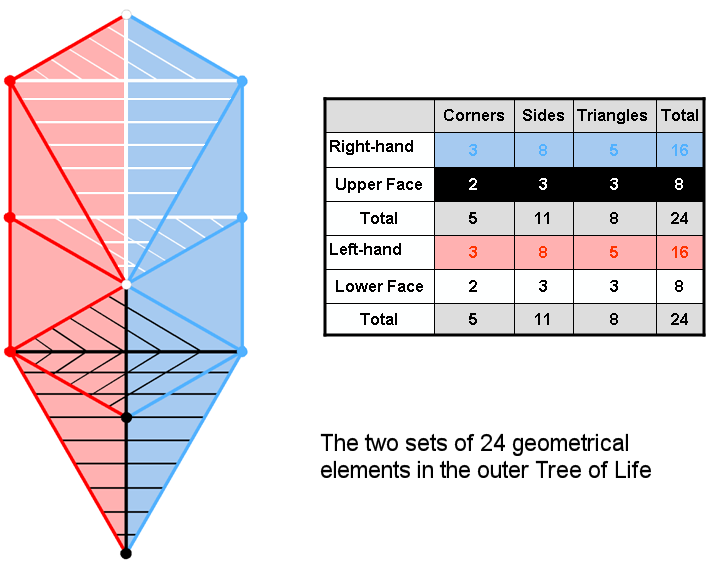 polygons other than the hexagon have 84 corners & triangles and 84 sides. As the lines are of
two types — sides of polygons and interior sides of sectors — 84 corners & sides line the boundaries of
these six polygons, which have 84 internal sides & triangles, so that there are two different ways of
understanding the 84:84 division in the case of separate polygons, one of which attributes the Yang/Yin
distinction to boundary and interior geometrical elements rather than to points & triangles and to lines.
As we shall shortly show, the 84:84 division arises from the distinction between the first five and the last
two polygons so that no resort to special pleading is needed for the enfolded polygons. As there is now no
correlation between types of geometrical elements and their Yang/Yin nature, the lack of a 24:24 division in
the geometrical composition of the outer Tree of Life no longer poses a problem, either. However, how 10
corners, 22 sides & 16 triangles can form two sets of 24 still needs explanation. Associated with each
vertical half of the outer Tree of Life outside the Pillar of Equilibrium are three corners, eight sides &
five triangles, i.e., 16 geometrical elements. Four corners (two in the Lower Face, two in the Upper Face) are
aligned with the central Pillar of Equilibrium, and six sides (three in the Lower Face, three in the Upper
Face) are associated with this pillar, as are six triangles (three in the Lower Face, three in the Upper
Face). So (2+3+3=8) geometrical elements are associated with each Face. There are (8+16=24) elements belonging
either to the right-hand side of the Tree of Life or to the Upper Face and 24 elements belonging to the
left-hand side or to the Lower Face. The former are Yang and the latter are Yin, as the Pillar of Mercy is
regarded by Kabbalists as embodying the masculine aspects of creation, whilst the Pillar of Judgement embodies
feminine aspects. The 48 geometrical elements, therefore, comprise two sets of 24, each
set comprising (3+2=5) corners, (8+3=11) sides & (5+3=8) triangles. Notice that each set of 24 comprises
eight corners & triangles and eight sides associated with a side pillar and eight corners, sides &
triangles associated with each Face and central Pillar, i.e., three sets of eight elements. This
is equivalent to eight sets of three, which is analogous to the eight upper or lower trigrams with 24 lines
& broken lines making up the eight diagonal hexagrams. If we assign the Yang polarity to the Upper Face as
well as to the masculine Pillar of Mercy and the Yin polarity to the Lower Face as well as to the feminine
Pillar of Judgement, the 48 geometrical elements making up the outer Tree of Life
comprise 24 Yang elements and 24 Yin elements. They correspond to the 24 lines and 24 broken lines of the
eight diagonal hexagrams of the I Ching table. However, the eight trigrams in their upper or lower halves
cannot correspond to, respectively, the right-hand geometrical elements/Upper Face and the left-hand
elements/Lower Face because each set of trigrams is made up of 12 lines (Yang) & 12 broken lines (Yin),
not 24 lines and 24 broken lines. This is not surprising, for although there is a blue counterpart to every
red geometrical element that is its reflection across the Pillar of Equilibrium, the black corners, sides
& triangles and the white corners, sides & triangles are not exact counterparts, even though they
comprise the same number of corners, the same number of sides and the same number of triangles (compare the
black and white rows in the table above). In order to understand the
polygons other than the hexagon have 84 corners & triangles and 84 sides. As the lines are of
two types — sides of polygons and interior sides of sectors — 84 corners & sides line the boundaries of
these six polygons, which have 84 internal sides & triangles, so that there are two different ways of
understanding the 84:84 division in the case of separate polygons, one of which attributes the Yang/Yin
distinction to boundary and interior geometrical elements rather than to points & triangles and to lines.
As we shall shortly show, the 84:84 division arises from the distinction between the first five and the last
two polygons so that no resort to special pleading is needed for the enfolded polygons. As there is now no
correlation between types of geometrical elements and their Yang/Yin nature, the lack of a 24:24 division in
the geometrical composition of the outer Tree of Life no longer poses a problem, either. However, how 10
corners, 22 sides & 16 triangles can form two sets of 24 still needs explanation. Associated with each
vertical half of the outer Tree of Life outside the Pillar of Equilibrium are three corners, eight sides &
five triangles, i.e., 16 geometrical elements. Four corners (two in the Lower Face, two in the Upper Face) are
aligned with the central Pillar of Equilibrium, and six sides (three in the Lower Face, three in the Upper
Face) are associated with this pillar, as are six triangles (three in the Lower Face, three in the Upper
Face). So (2+3+3=8) geometrical elements are associated with each Face. There are (8+16=24) elements belonging
either to the right-hand side of the Tree of Life or to the Upper Face and 24 elements belonging to the
left-hand side or to the Lower Face. The former are Yang and the latter are Yin, as the Pillar of Mercy is
regarded by Kabbalists as embodying the masculine aspects of creation, whilst the Pillar of Judgement embodies
feminine aspects. The 48 geometrical elements, therefore, comprise two sets of 24, each
set comprising (3+2=5) corners, (8+3=11) sides & (5+3=8) triangles. Notice that each set of 24 comprises
eight corners & triangles and eight sides associated with a side pillar and eight corners, sides &
triangles associated with each Face and central Pillar, i.e., three sets of eight elements. This
is equivalent to eight sets of three, which is analogous to the eight upper or lower trigrams with 24 lines
& broken lines making up the eight diagonal hexagrams. If we assign the Yang polarity to the Upper Face as
well as to the masculine Pillar of Mercy and the Yin polarity to the Lower Face as well as to the feminine
Pillar of Judgement, the 48 geometrical elements making up the outer Tree of Life
comprise 24 Yang elements and 24 Yin elements. They correspond to the 24 lines and 24 broken lines of the
eight diagonal hexagrams of the I Ching table. However, the eight trigrams in their upper or lower halves
cannot correspond to, respectively, the right-hand geometrical elements/Upper Face and the left-hand
elements/Lower Face because each set of trigrams is made up of 12 lines (Yang) & 12 broken lines (Yin),
not 24 lines and 24 broken lines. This is not surprising, for although there is a blue counterpart to every
red geometrical element that is its reflection across the Pillar of Equilibrium, the black corners, sides
& triangles and the white corners, sides & triangles are not exact counterparts, even though they
comprise the same number of corners, the same number of sides and the same number of triangles (compare the
black and white rows in the table above). In order to understand the
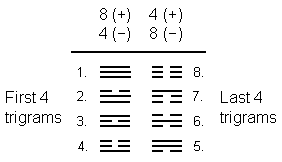
correct correspondence between geometrical elements and the lines & broken lines, let us, firstly, examine the composition of the eight trigrams in more detail. They divide into two sets of four, the second set being generated from the first set by replacing each line by a broken line and vice versa. The first four trigrams consist of eight lines (+) & four broken lines (−); the last four trigrams comprise four lines (+) & eight broken lines (−). According to the table in the diagram above, in the Upper Face are two white corners, three white sides & three white triangles. Let us associate one of these corners with the three sides and the other corner with the three triangles (we need not be concerned which corner should be associated with the sides and which corner with the triangles). Similarly, in the Lower Face are two black corners, three black sides & three black triangles, so let us associate one black corner with the black sides and the other with the black triangles. This means that the eight white geometrical elements in the Upper Face comprise two sets of four (a corner & either three sides or three triangles). Similarly, it means that the eight black geometrical elements in the Lower Face comprise two sets of four. The 16 right-hand elements consist of (3+5=8) blue corners & triangles and eight blue sides. The 16 left-hand elements consist of (3+5=8) red corners & triangles and eight red sides. The following table compares the 48 geometrical elements in the outer Tree of Life with the 48 lines & broken lines in the two sets of eight trigrams making up the eight diagonal hexagrams:

The pattern of geometrical elements is the same as the pattern of lines and broken lines. The distinction between the upper and lower sets of eight trigrams manifests in the Tree of Life because the latter can be divided into two regions that contain the same numbers of geometrical elements of each type.
The 84:84 division of 168
That this
168:48:168 pattern is not the result of either coincidence
or ad hoc concoction is indicated by the following considerations. Tabulated below are the numbers of
unshared geometrical elements in the seven enfolded, Type A polygons outside the root edge:
| Triangle | Square | Pentagon | Hexagon | Octagon | Decagon | Dodecagon |
Total |
|
| Corners | 1 | 3 | 3 | 2 | 7 | 9 | 11 | 36 |
| Sides | 5 | 7 | 9 | 7 | 15 | 19 | 23 | 85 |
| Triangles | 3 | 4 | 5 | 5 | 8 | 10 | 12 | 47 |
| Total | 9 | 14 | 17 | 14 | 30 | 38 | 46 | 168 |
"Corners" refer to sectors of polygons, i.e., the numbers include their centres, and "Triangles" refer to these sectors. If, for the purpose of counting, we treat the outermost corner of the pentagon as belonging to the decagon because it is its centre, the first five polygons have 84 geometrical elements (16 corners, 43 sides, 25 triangles), as have the last two polygons (20 corners, 42 sides, 22 triangles). This 84:84 division of 168 is characteristic of holistic systems, as is attested to by many examples discussed in this website. If the appearance of the number 168 were a coincidence, how likely would it be that a set of consecutive polygons (not even just some random combination) would also by chance divide this number in half, as required to be consistent with other holistic systems? Clearly, it would be highly improbable. It is the amazing, analogous properties of such systems, not chance, that is showing itself here.
The seven enfolded polygons have 85 sides outside the root edge that are unshared with the outer Tree of Life, where 85 = 40 + 41 + 42 + 43. This shows how the Tetrad expresses the properties of the inner Tree. Including the root edge, there are 86 unshared sides, where
86 = 21 + 15 + 50
is the sum of the number values of EHYEH, YAH & ELOHIM, the Godnames of the Sephiroth belonging to the Supernal Triad. 87 sides are outside the root edge, where 87 is the number value of Levanah, the Mundane Chakra of Yesod.
The triangle, square, pentagon & decagon have 78 geometrical elements outside the root edge unshared with the outer Tree of Life and the hexagon, octagon & dodecagon have 90 such geometrical elements. The two numbers are the number values of Cholem and Yesodoth in the Kabbalistic name of the Mundane Chakra:
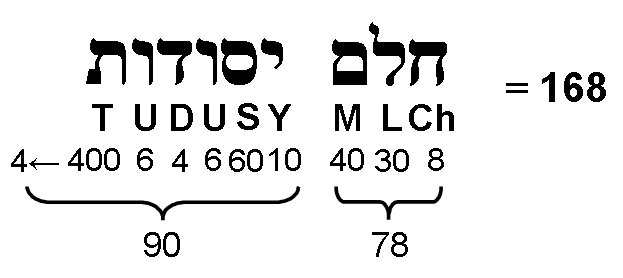
It is easily confirmed that these two sets of polygons are the only possible combinations of polygons that generate them.
The Tree of Life comprises 10 corners & 22 sides of 16 triangles. According to the table, the two sets of enfolded polygons and the Tree of Life have (10 + 2×36 = 82) corners & (22 + 2×85 = 192) sides of (16 + 2×47 = 110) triangles (all outside the root edge). The number of triangles in the outer and inner Trees of Life is determined by the Decad because 110 is the sum of the first ten even integers:
|
2 |
||||
|
4 |
6 | |||
| 110 = |
8 |
10 |
12 |
|
| 14 | 16 | 18 |
20 . |
The Decad also determines the 384 geometrical elements outside the root edge belonging to the outer & inner Trees of Life because 384 is the sum of the squares of the nine integers 2-10 surrounding the central 12 in the tetractys array:
|
22 |
|||
|
32 |
42 | ||
|
52 |
12 |
62 |
|
| 72 | 82 | 92 |
102 . |
This is the beautiful, arithmetic counterpart of the sacred geometry of the outer & inner Trees, with 12 (= 1) playing the role of the originating root edge. The possession by the 14 enfolded polygons of the holistic parameter 384 should be compared with the discussion in #12 of the 14 separate Type A polygons, where it was found that 384 geometrical elements surround their centres, of which 48 belong to the two hexagons and (168+168) belong to the two sets of six other polygons. Whether separate or combined with the outer Tree, the two sets of seven polygons display the same 168:48:168 division that is characteristic of holistic systems. In the former case, the two separate Type A hexagons with 48 geometrical elements surrounding their centres correspond to the 48 geometrical elements making up the outer Tree of Life. For other examples of this pattern, see #19 at Wonders of sacred geometry/Correspondences.
The 110 triangles making up the Tree of Life and the sectors of the (7+7) enfolded polygons have 82 corners and 192 sides outside the root edge, that is, 274 corners & sides. 274 is the 137th even integer. This shows how the mysterious number 137 determining approximately the fine-structure constant as its reciprocal measures the number of points and lines making up the outer & inner forms of the Tree of Life.
| << Previous 1... 29 30 [31] 32 33 ...40 Next >> |